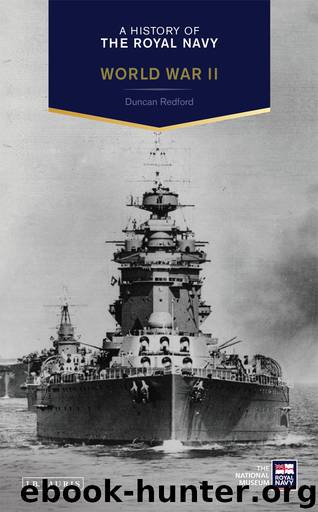A History of the Royal Navy: World War II by Duncan Redford

Author:Duncan Redford [Redford, Duncan]
Language: eng
Format: epub
ISBN: 9780857735058
Publisher: I.B.Tauris
Fig. 4.2. The ‘Channel Dash’, February 1942.
First to make their attack were the five MTBs supported by motor gunboats. Under heavy fire from the outer screen of German E-boats and destroyers, which were also faster than the British MTBs, there was no real option except to fire the torpedoes at long range. This gave the Germans plenty of time to alter course to avoid them and consequently the MTBs scored no hits. Just as the MTBs were attempting to withdraw, the six Swordfish and a fraction of the promised escort of three squadrons of RAF Spitfires commenced their attack – the two additional squadrons of Spitfires tasked with attacking the German anti-aircraft gunners did not arrive at all. Attacking in two sub-flights of three aircraft, the Swordfish were mercilessly attacked by German fighters; by the time the first sub-flight passed over the screen of E-boats and destroyers, all three had been damaged and the leading aircraft flown by Lieutenant Commander Eugene Esmonde had had one of its lower wings almost completely shot away. Esmonde, whose aircraft got to within 3,000 yards of the German battlecruisers before being hit again and crashing into the sea, was awarded a posthumous Victoria Cross for his bravery. The remaining two aircraft continued to close and both dropped their torpedoes before crashing. Again no hits were scored. The second flight of three Swordfish torpedo bombers were last seen flying straight towards the German ships. Once they passed beyond the ring of E-boats and destroyers, they were not seen again.
Throughout the afternoon Bomber Command aircraft – a total of some 242 in three waves – tried to find the German ships, but only 39 actually managed to do so and attack. All failed to score a hit. Some also managed to bomb the Royal Navy’s destroyers which were closing on the German convoy from the north-west, although happily in this case the RAF’s aim did not improve. In part the failure by Bomber Command to damage the German ships was due to the poor weather; cloud cover made it difficult to find the ships – a clear reminder of the limitations of airpower in this period. However, the impact of RAF doctrine cannot be ignored. The RAF doctrine – some might say doctrinaire approach – was that airpower was indivisible and flexible. This meant that a centrally controlled bomber force could be used against a wide range of targets without the need for it to be broken up into small packets and farmed out to those who wanted air support. However, hitting warships from high altitude was extremely difficult and Bomber Command, as evidenced by the Butt and Singleton reports of 1941 and 1942, had problems hitting cities, let alone fast-manoeuvring ships. Meanwhile, snow was hampering the move of 28 RAF torpedo bombers to the area from the north of Britain; they were able to attack only after the Germans were well past Dover and again scored no hits.12
While this massive and, from a British perspective,
Download
This site does not store any files on its server. We only index and link to content provided by other sites. Please contact the content providers to delete copyright contents if any and email us, we'll remove relevant links or contents immediately.
| Africa | Americas |
| Arctic & Antarctica | Asia |
| Australia & Oceania | Europe |
| Middle East | Russia |
| United States | World |
| Ancient Civilizations | Military |
| Historical Study & Educational Resources |
Flight by Elephant(1480)
The Rise and Fall of the Third Reich: A History of Nazi Germany by William L. Shirer(1382)
Unbroken: A World War II Story of Survival, Resilience, and Redemption by Hillenbrand Laura(1099)
German submarine U-1105 'Black Panther' by Aaron Stephan Hamilton(1018)
Last Hope Island by Lynne Olson(933)
A Bridge Too Far by Cornelius Ryan(927)
War by Unknown(904)
The Victors - Eisenhower and His Boys The Men of World War II by Stephen E. Ambrose(900)
The Guns at Last Light: The War in Western Europe, 1944-1945 by Rick Atkinson(887)
Rogue Heroes: The History of the SAS, Britain's Secret Special Forces Unit That Sabotaged the Nazis and Changed the Nature of War by Ben Macintyre(882)
0060740124.(F4) by Robert W. Walker(871)
The Hitler Options: Alternate Decisions of World War II by Kenneth Macksey(865)
The Railway Man by Eric Lomax(846)
All the Gallant Men by Donald Stratton(814)
Hitler's Vikings by Jonathan Trigg(807)
A Tragedy of Democracy by Greg Robinson(800)
Churchill's Secret War by Madhusree Mukerjee(796)
Hitler's Armies by Chris McNab(781)
We Die Alone: A WWII Epic of Escape and Endurance by David Howarth & Stephen E. Ambrose(745)
